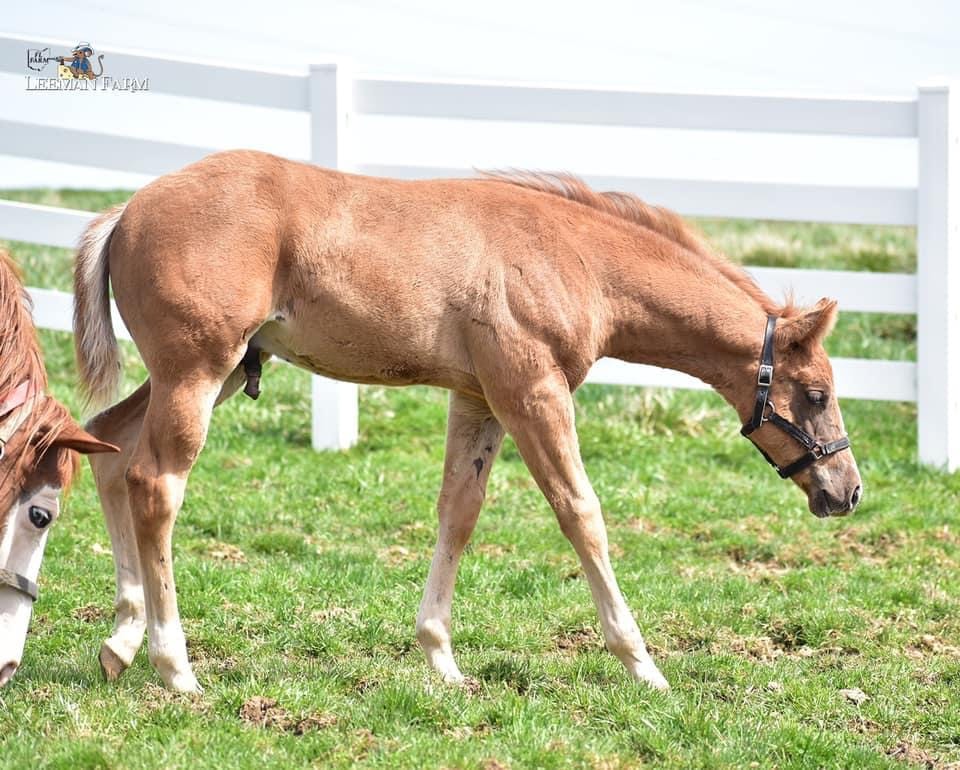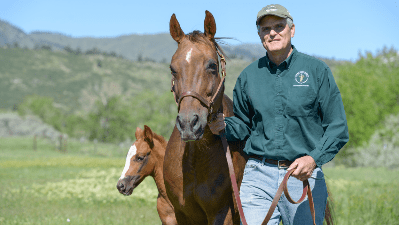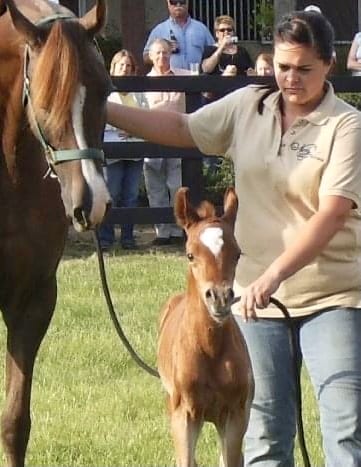Foaling season is in full swing and arguably one of the most exciting times of the year for most mare owners. The season brings eager anticipation, hopeful expectations, and possibly some anxiety and sleepless nights. The average gestation length of a mare is about 340-342 days, but it can vary depending on the mare.
Most mares can foal naturally and do not need intervention. However, there are instances when there are complications, and for that reason, mare owners need to be able to predict foaling and recognize foaling signs. Many physical changes in the mare start a month or so before foaling, but as the delivery date nears, changes in the mare really start to become noticeable.
We gathered information from Dr. Patrick McCue, a senior faculty member at Colorado State University’s (CSU) Equine Reproduction Laboratory (ERL), coordinating the Clinical Stallion, Broodmare, Foaling Embryo Transfer services. We also talked with Lauren Erk, the breeding manager at Leeman Farm, one of the most prestigious Quarter Horse farms in the world, located in Massillon, Ohio.
Leeman Farm offers a full-service breeding facility equipped to handle all breeding needs; onsite services include cycle management, embryo transfer, and foal out services. Leeman Farm stands some of the industry’s leading performance stallions, including the late Invitation Only, Lazy Loper, How Bout This Cowboy, and Willy Be Invited.
Lauren Erk, Breeding Manager of Leeman Farm
Lauren Erk described their process at Leeman Farm for preparing for the foaling season, outlined the foaling prediction, and explained what to do when a mare is foaling. Leeman Farm generally foals around 20-30 mares each season. Preparation includes; stripping all the stalls in the foaling barn, disinfecting the stalls, and having their foaling kits.
Leeman Farm uses several methods to predict when their mares will foal. Breeding and foaling records are kept on all the mares that are on the premises. Tracking the pattern of a mare can help determine gestation length. Lauren stated that most mares on their records foal between 330 days and 350 days. However, they have some mares that will foal 2-3 weeks early every year, and some go an entire year, which confirms the importance of keeping accurate records.
Erk stated, “We do use pool strips to test the pH and calcium levels of the milk, but we do not rely 100% on them, just as an aid to help predict.” In their mare records, they take note of the milk levels, if the mares get wax, the time between when milk comes in and when they foal, the type of milk they may get (thick syrup consistency or water), the amount of time the mare drips milk (noting if the foal fails to pass their immunoglobulin antibody test or IgG), and if the mare’s milk comes in after they foal.
 The foal will fail the IgG test if it hasn’t consumed enough colostrum or the mare did not effectively transfer antibodies to the foal through colostrum, increasing the risk of infection or illness for the foal. It is crucial to all of these details in the mare’s records for successful future foaling seasons.
The foal will fail the IgG test if it hasn’t consumed enough colostrum or the mare did not effectively transfer antibodies to the foal through colostrum, increasing the risk of infection or illness for the foal. It is crucial to all of these details in the mare’s records for successful future foaling seasons.
The mare will also show physical signs of foaling when the time is getting close. Lauren described the signs they look for, “…loosening of the muscles around the tail head, vulva softening and elongating, and the belly dropping into a teardrop shape which is the baby positioning.”
Furthermore, some mares will exhibit behavioral changes such as going off their grain or increasing the amount of walking in their stalls. Leeman Farm has several staff members that take shifts watching mares on stall cameras. Staff members watch the patterns that mares have, and when they deviate from them, the changes can be a sign that foaling is approaching.
Erk states, “Some mares never lay down, and some mares will also want to be by themselves when turned out in pasture instead of with the group or a buddy.”
Lauren described their process when a mare starts to foal. When a mare is approaching her time to foal, staff will wrap her tail to help see the water break and the amniotic bubble if the mare is laying down. Staff will do periodic checks during the day on the stall cameras if they are not near the barn, and during the night, staff check-in hourly on the cameras. Staff also makes sure the foaling kit is ready to go and nearby.
Erk said their foaling kits include “rubber gloves, Banamine, tranquilizer, Ivermectin wormer for the mare once she foals, Nolvasan solution to spray the navel, towels to dry the baby, naval clamp in case the mare breaks the umbilical too soon, garbage bag for the placenta, and an enema for the foal.”
A few extra items to have on hand are; bottles to collect colostrum off the mare if she is heavy milkers and pulling chains if the mare needs assistance. Lastly, Lauren recommends always having the truck and trailer hooked up in case of dystocia, and the mare and foal need to go to the vet clinic.
Lauren shared this advice for those foaling out mares for the first time, “Don’t be afraid to ask questions of your vet or from the breeding farm. If you are unsure of something, please ask. There are no dumb questions, and we are always willing to help in any way we can with answers.”
Dr. Patrick McCue, Colorado State University Equine Reproduction Laboratory
 Dr. McCue states, “The best way to predict the date of foaling is to utilize all available information on an individual mare.” In looking at the information available, the first place to start is the history of a mare, the last ovulation date or breeding date, and previous pregnancies.
Dr. McCue states, “The best way to predict the date of foaling is to utilize all available information on an individual mare.” In looking at the information available, the first place to start is the history of a mare, the last ovulation date or breeding date, and previous pregnancies.
If the breeding date is known, the foaling date can be calculated based on 340-342 days gestation length. Additionally, if the foaling history is known, the foaling date can be found on previous pregnancies’ gestational length.
The mare will display physical changes as the foaling date gets close. Mammary gland development starts 2-4 weeks before foaling in most mares, enlarging ventrally first, then filling in more dorsally before the teat ends engorge with milk. The engorgement of teat ends will occur a few days before the actual foaling date.
Some mares will wax up within the last few days. Waxing is the accumulation of dried colostrum at the teat end. Dr. McCue noted that at the Equine Reproduction Laboratory at CSU, approximately 70% of the mares in their program showed signs of waxing, and then 70% of those mares foaled within 72 hours.
From a testing standpoint, monitoring milk calcium concentration in the late-term gestational mare is pervasive. Once samples of mammary fluid can be collected, testing for milk calcium concentrations can be done using diagnostics such as FoalWatch or Predict-A-Foal.
 Dr. McCue reported the results from using FoalWatch at the ERL, “Once enough milk calcium concentration was able to be collected, 50ppm (parts per million) were detected, and the milk calcium level stayed the same for a day. The concentration rose to about 80ppm and increased dramatically to 250ppm, and the mare foaled later that night.” FoalWatch and Predict-A-Foal can be purchased, and any mare owner at home can determine milk calcium levels.
Dr. McCue reported the results from using FoalWatch at the ERL, “Once enough milk calcium concentration was able to be collected, 50ppm (parts per million) were detected, and the milk calcium level stayed the same for a day. The concentration rose to about 80ppm and increased dramatically to 250ppm, and the mare foaled later that night.” FoalWatch and Predict-A-Foal can be purchased, and any mare owner at home can determine milk calcium levels.
The pH levels or the measurement of mammary fluid’s acidity can also track impending foaling. The pH can be measured with an electronic meter or pH paper. If using pH test strips, it is recommended to use paper tests that will determine pH levels with a range from 6-8. pH test strips with a more extensive range can be less accurate.
The ERL found pH levels a week before foaling will be around 7.5. Within the last 24 hours before foaling, the pH dramatically drops to 6.4. The pH test strips are convenient and low-cost, but not all mares will experience a drop in milk pH before foaling. pH test strips can be purchased and used at home.
Lastly, the mare’s vulva’s swelling and elongation may also help predict the time of foaling. This physical change will happen within the hours or even minutes before foaling. Dr. McCue emphasized that all of this information is pertinent to foaling, “…no single parameter is universally indicative of impending foaling.”
Foaling can be a very stressful and tedious time for owners, farm managers, and foaling staff. Remember that every mare is different, and no single prediction method is 100% accurate. Combining approaches and techniques will help determine the time of foaling and help everyone prepare for the much-anticipated beautiful occasion.










